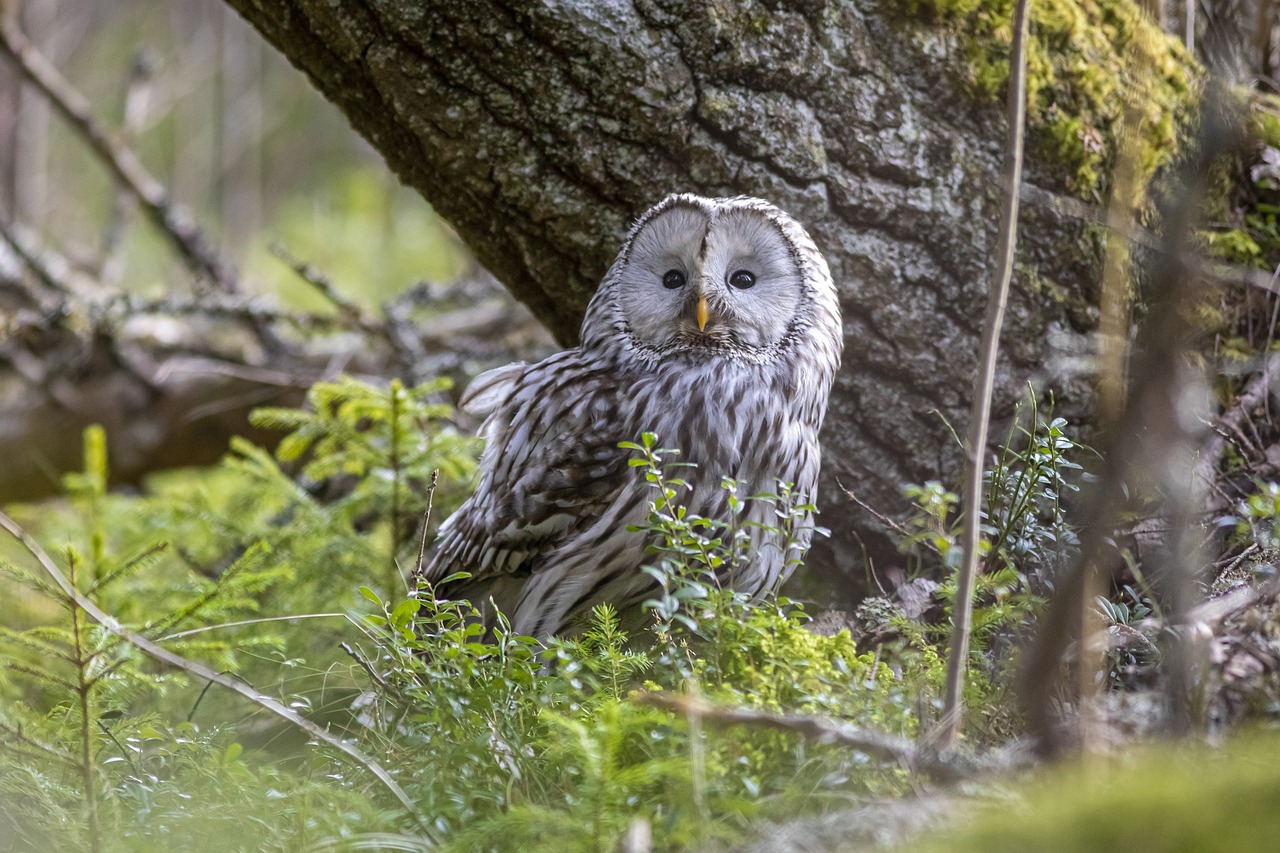Here’s a complete and detailed overview of the Ural Owl (Strix uralensis) — one of Europe and northern Asia’s most majestic and powerful forest owls.
🦉 Ural Owl (Strix uralensis)
Taxonomy
- Kingdom: Animalia
- Phylum: Chordata
- Class: Aves
- Order: Strigiformes
- Family: Strigidae
- Genus: Strix
- Species: S. uralensis
Common names:
Ural Owl, Ural Wood Owl, Great Grey Wood Owl (not to be confused with Strix nebulosa).
General Description
The Ural Owl is a large, long-tailed, round-headed owl without ear tufts. It’s known for its serene facial expression, soft grey plumage, and deep, hooting call echoing through boreal forests.
- Length: 50–62 cm
- Wingspan: 110–134 cm
- Weight:
- Males: 500–730 g
- Females: 720–1300 g (larger and heavier)
- Plumage:
- Pale grey or brownish-grey with fine dark streaks.
- Broad round face with concentric feather rings and dark eyes.
- Underparts lighter, streaked vertically.
- Tail long and rounded — a key distinction from other Strix owls.
Distribution
The Ural Owl has a wide Palearctic range, spanning northern and central Eurasia.
- Europe: From Scandinavia, Estonia, and Finland south to Austria, Poland, and the Balkans.
- Asia: Across Russia, Siberia, northern China, Korea, and Japan (Hokkaido).
- Isolated populations: In the Alps, Carpathians, and Balkan mountains.
Habitat
Prefers dense, old-growth mixed or coniferous forests, often near clearings, meadows, or bogs.
- Common in boreal (taiga) and montane forests.
- Nests in tree cavities, broken trunks, or large stick nests (often those of hawks or crows).
- Requires mature woodland with open hunting areas.
Behavior and Ecology
- Activity: Mostly nocturnal, but often active at dawn and dusk — and sometimes in daylight, especially during breeding.
- Territoriality: Very territorial; pairs defend territories year-round.
- Vocalization:
- Deep, rhythmic hooting call: “Whoo-hoo-hoo, whoo-hoo” — slow and haunting.
- Females have higher-pitched versions.
- Calls carry over 2 km in still air.
- Flight: Silent and smooth, with broad, rounded wings.
Diet
A specialist predator of small mammals, particularly voles, but also a versatile hunter.
- Primary prey:
- Voles (Microtus spp.), mice, and shrews.
- Secondary prey:
- Small birds, frogs, and large insects.
- Hunting method:
- Perch-hunting — the owl sits silently, scanning and listening for prey before swooping down.
- Acute hearing allows detection of movement beneath snow or leaf litter.
Reproduction
- Breeding season: March–May (earlier in southern range).
- Nesting:
- Uses natural cavities, broken tree tops, or old raptor nests.
- Readily accepts nest boxes in managed forests.
- Clutch size: 2–6 eggs (usually 3–4).
- Incubation: ~28–33 days, by the female.
- Fledging: Young leave the nest at 3–4 weeks, but can’t fly for another 2–3 weeks — during which they climb branches near the nest and are fed by parents.
- Parental defense:
- The Ural Owl is notoriously aggressive in defense of its nest and may attack intruders, including humans.
Lifespan
- Wild: Typically 10–20 years.
- Captivity: Up to 30 years.
Predators and Threats
- Natural predators: Rare — large eagles or martens may take young.
- Main threats:
- Loss of mature forest habitat due to logging.
- Decline in prey populations in harsh winters.
- Vehicle collisions and nest disturbance.
Conservation Status
- IUCN Red List: 🟩 Least Concern
- Population trend: Stable to increasing in parts of Europe due to reforestation and nest-box programs.
- In Estonia, Finland, and Sweden, populations are stable and well-monitored.
Subspecies
There are up to 15 subspecies, varying slightly in coloration and size.
Notable ones include:
- S. u. uralensis — Scandinavia to western Russia (pale grey).
- S. u. liturata — Siberia (darker plumage).
- S. u. nikolskii — Japan (darkest form).
Identification Summary
| Trait | Description |
|---|---|
| Head | Round, no ear tufts |
| Eyes | Dark brown to black |
| Plumage | Pale grey with dark streaks |
| Tail | Long and rounded |
| Call | Deep hoots: “Whoo-hoo-hoo, whoo-hoo” |
| Habitat | Old mixed forests near clearings |
| Range | Northern & Central Eurasia |
| Behavior | Territorial, aggressive near nest |
Interesting Facts
- The Ural Owl’s call is often used as a sound cue in European films to evoke mysterious or eerie forest scenes.
- Despite its size, it’s often hard to spot due to silent flight and camouflage plumage.
- In Estonia and Finland, it’s considered a symbol of healthy, old-growth forests.
- Nest boxes have significantly helped population recovery in managed forests across northern Europe.
Views: 1693
Subscribe to the newsletter:
